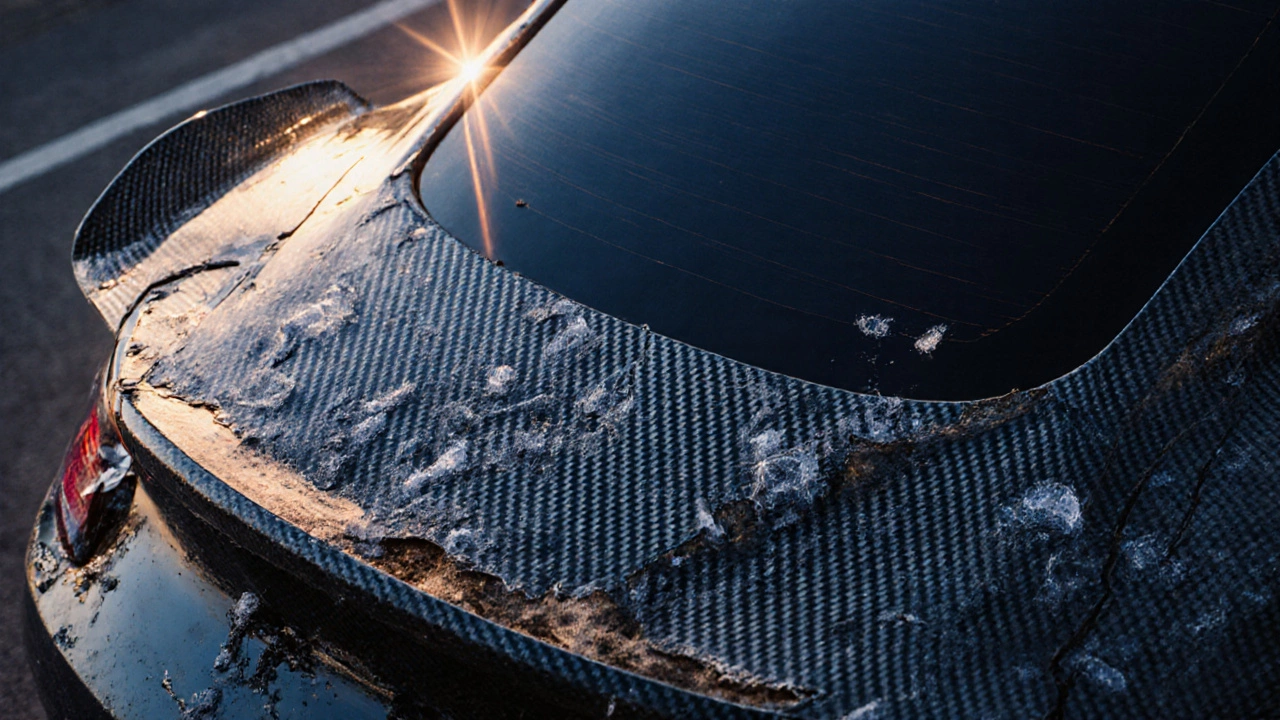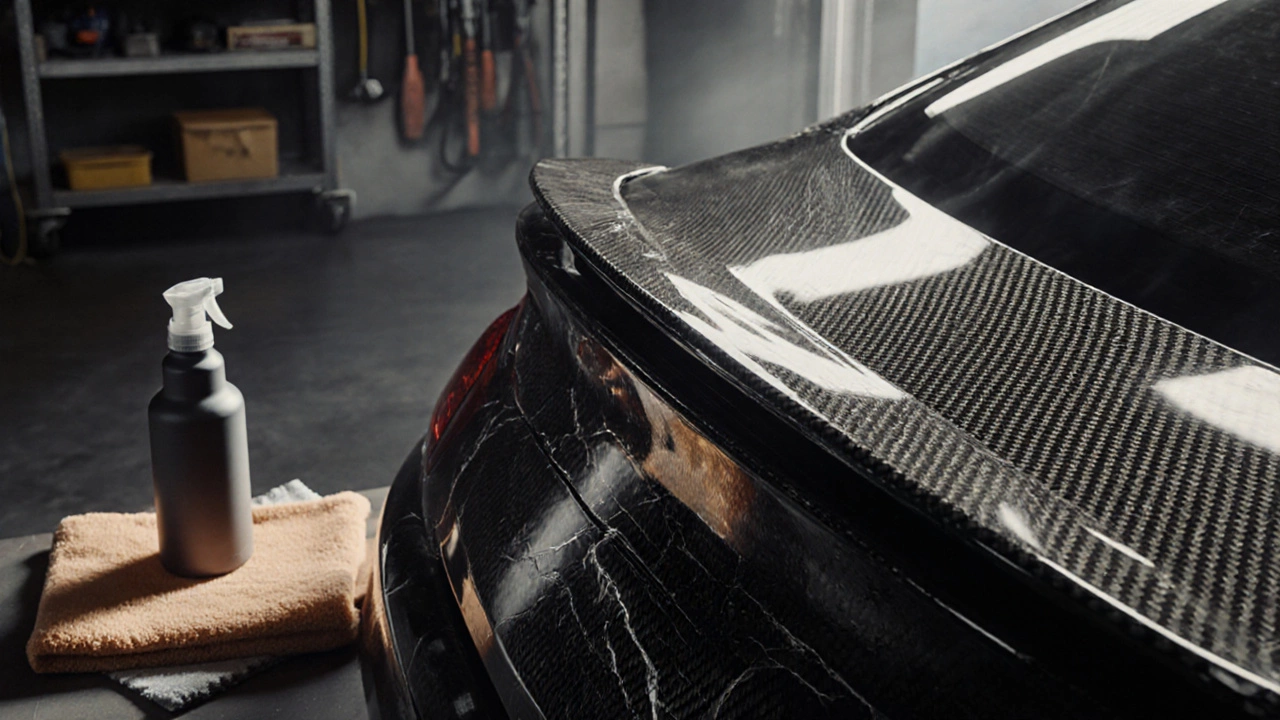Carbon Fiber Lifespan Estimator
How Your Carbon Fiber Degrades
Carbon fiber itself doesn't weaken—but the resin binding it breaks down from UV, temperature swings, and chemicals. This tool estimates your part's lifespan based on real-world conditions.
Your Carbon Fiber Type
Environmental Factors
Maintenance Habits
Enter your details and click Calculate Lifespan to see your spoiler's estimated lifespan.
Your Estimated Lifespan
Key Factors Affecting Your Lifespan
Carbon fiber spoilers look sharp. They reduce drag, add downforce, and turn heads on the highway. But if you’ve owned one for a few years, you might’ve noticed something off-small cracks near the edges, a slight loss of stiffness, or maybe a weird creak when you hit a bump. That’s when the question pops up: does carbon fiber get brittle over time? The short answer? Yes, but not the way most people think.
Carbon fiber isn’t metal-it doesn’t rust, but it doesn’t last forever either
People assume carbon fiber is indestructible because it’s used in fighter jets and Formula 1 cars. But those are engineered systems with strict maintenance cycles. Your aftermarket spoiler? It’s exposed to UV rays, road salt, temperature swings, and impacts that no lab test ever simulated.
The carbon fibers themselves? They’re stable. Super stable. They won’t degrade under normal conditions. But carbon fiber isn’t just fibers. It’s fibers soaked in resin-usually epoxy. And that resin? That’s the weak link.
Epoxy resin starts to break down when it’s bombarded by sunlight. UV radiation doesn’t burn the carbon; it attacks the polymer chains holding everything together. Over time, the resin becomes chalky, loses its flexibility, and starts to micro-crack. Think of it like plastic left on a dashboard for years-it yellows, cracks, and feels brittle. Same thing happens under your spoiler.
What actually causes carbon fiber to fail? It’s not age-it’s environment
Here’s what really kills carbon fiber parts in the real world:
- UV exposure: After 3-5 years in direct sunlight, the resin starts to lose its gloss and becomes more prone to cracking. In places like Adelaide, where summer UV levels hit 12+ on the index, this happens faster.
- Thermal cycling: Your spoiler heats up to 60°C on a hot day, then cools to 5°C at night. That expansion and contraction stresses the bond between fibers and resin. Over thousands of cycles, micro-cracks form.
- Physical impacts: A curb scrape, a stone chip, even a car wash brush can cause delamination. Once the layers separate, moisture gets in, and the damage spreads.
- Chemical exposure: Road salt, brake dust, and even some cleaning products eat away at the resin surface. Acidic cleaners? They’re especially bad.
It’s not that the carbon fibers are turning brittle-it’s that the glue holding them together is failing. And once the resin cracks, the fibers lose their support. That’s when you see flaking, peeling, or sudden fractures under stress.
How long do carbon fiber spoilers actually last?
There’s no fixed expiration date, but here’s what real-world data shows:
- Low-quality aftermarket parts: 2-4 years before visible degradation. Often made with hand-laid resin, thin fiberglass backing, and no UV protection.
- Mid-tier OEM-style: 5-8 years. These use better resin blends and sometimes have a clear coat with UV inhibitors.
- High-end racing or factory parts: 10+ years. These are autoclave-cured, use aerospace-grade epoxy, and have multi-layer protective coatings.
One owner in Perth sent us photos of his 2015 carbon fiber spoiler after 11 years. It had minor surface crazing, but no cracks or delamination. His secret? He washed it weekly, used a ceramic coating, and parked in the garage. The fibers were still intact. The resin? Just worn.

Can you prevent carbon fiber from degrading?
Yes. And it’s not expensive.
Start with protection:
- Apply a ceramic coating: A professional-grade ceramic coating with UV blockers can extend the life of the resin by 3-5 years. It’s not a paint job-it’s a glass-like shield that bonds to the surface.
- Wash regularly: Salt and grime build up under the edges of spoilers. Rinse it monthly, especially after rain or coastal drives.
- Avoid harsh cleaners: No engine degreasers, no acetone, no abrasive sponges. Use pH-neutral car shampoo and microfiber towels.
- Keep it shaded: If you park outside, use a car cover. Even a basic one cuts UV exposure by 80%.
- Inspect for damage: Look for tiny cracks near bolt holes or edges. Catch them early, and you can repair them with a small epoxy patch before moisture gets in.
One guy in Melbourne had a 2018 Audi RS5 spoiler that started cracking after 3 years. He tried rubbing compound-it made it worse. Then he got it professionally refinished with a new clear coat. It’s been 5 years since, and it looks brand new. The fix cost $280. Replacing it? $1,800.
What about cheap carbon fiber look-alikes?
Watch out for “carbon fiber” parts that are actually fiberglass with a printed film glued on top. These aren’t real carbon fiber. They’re plastic with a pattern. They’ll fade, peel, and crack in under a year. Real carbon fiber has a distinct weave pattern you can feel-it’s not flat. If the surface feels like smooth plastic, it’s fake.
How to tell? Look at the edges. Real carbon fiber has multiple layers of weave visible on the cut edges. Fake ones have a single-layer print. If it’s sold for under $150 on Amazon or eBay, it’s almost certainly not real carbon fiber.

When should you replace a carbon fiber spoiler?
You don’t need to replace it just because it looks old. But here are signs it’s time:
- Cracks that go deeper than the surface-especially near mounting points.
- Delamination: sections peeling away from the base, or air bubbles under the surface.
- Structural flex: if the spoiler wobbles or bends when you press on it, the internal structure is compromised.
- Moisture inside: if you see rust on the mounting bolts or water pooling under the spoiler, the seal is gone.
If you see any of those, don’t wait. A failing spoiler can detach at high speed. That’s not just a cosmetic issue-it’s a safety risk.
Real carbon fiber lasts decades-if you treat it right
Carbon fiber isn’t like steel. It doesn’t rust. It doesn’t corrode. But it’s not magic. It needs care. The fibers will outlive you. The resin? Not so much.
Think of your spoiler like a leather jacket. It looks better with age-if you condition it. Skip the maintenance, and it’ll crack and fall apart. Do the basics, and it’ll look sharp for a decade or more.
Most people buy carbon fiber for the look. But if you want it to last, treat it like the high-performance part it is. Not a decoration. Not a status symbol. A precision component.
And if you’re shopping for a new one? Spend the extra $300 for a properly cured, UV-protected part. You’ll save money in the long run. And your neighbors will still be staring at it five years from now.
Does carbon fiber get brittle over time?
Yes, but not because the carbon fibers themselves degrade. The resin that binds them breaks down due to UV exposure, heat cycling, and physical stress. Over time, this makes the surface brittle and prone to cracking. The fibers stay strong-the glue fails.
How long do carbon fiber spoilers last?
Low-quality aftermarket spoilers last 2-4 years. Well-made OEM-style parts last 5-8 years. High-end racing or factory parts with proper coatings can last 10+ years. Lifespan depends mostly on UV protection, maintenance, and installation quality.
Can you repair a cracked carbon fiber spoiler?
Yes, if the damage is surface-level. Minor cracks can be filled with epoxy resin and re-coated. For deeper cracks or delamination, professional repair is needed-this involves sanding, re-laying fibers, and curing under heat. DIY repairs often fail if the resin isn’t properly bonded.
Is ceramic coating worth it for carbon fiber?
Absolutely. A ceramic coating blocks 95% of UV rays and resists chemicals and dirt. It’s the single best way to extend the life of your spoiler. A professional application costs $200-$400 and can add 5+ years of protection.
Are all carbon fiber parts real carbon fiber?
No. Many cheap parts are fiberglass with a printed carbon pattern. Real carbon fiber has a 3D weave you can feel, and the edges show multiple layers. If it’s under $150, it’s likely fake. Always check the manufacturer’s specs and look for real resin transparency, not paint.
If you’re still unsure about your spoiler’s condition, take a close-up photo of the edges and cracks. Compare it to images of known degraded parts online. Most auto detailing shops will inspect it for free. Better to know now than to find out the hard way on the highway.